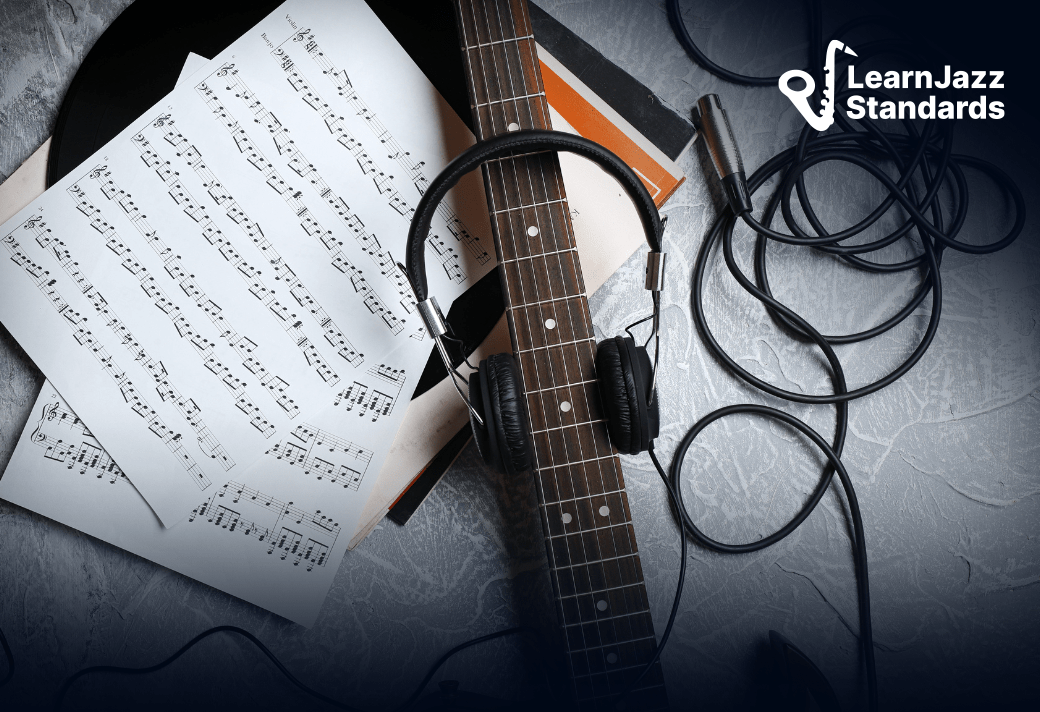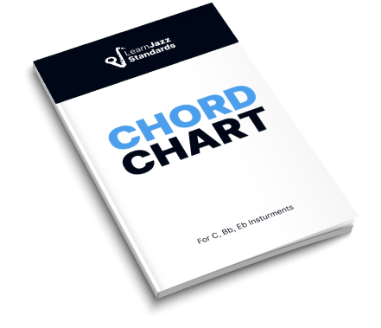The Lydian scale is a beautiful-sounding variation on the major scale with specific improvisation uses. In this article, we’ll explore the Lydian scale and learn why it is unique.
We’ll cover—
- The Lydian mode and its place among the other modes
- The Lydian scale’s formula and structure
- All 12 Lydian scales (every key on guitar and piano)
- When to use Lydian in your jazz solos
- Other Lydian-sounding jazz scales
Be sure to listen to the audio examples of the Lydian scales listed below!
Also, if you are trying to improve your jazz playing skills by learning the Lydian mode and other useful scales, you should check out the Learn Jazz Standards Inner Circle.
The Inner Circle is an incredible community of like-minded musicians who are passionate about learning jazz and improving their jazz chops by studying… you’ve guessed it… Jazz Standards.
We believe that jazz standards contain all the language, vocabulary, and insight you need to become a jazz maestro. If you are trying to learn jazz and want to seriously up your game, check out the Inner Circle and let the music teach you how to play!
Table of Contents
What is the Lydian Scale?
The Lydian scale is one of the modes of the major scale. Specifically, it is the mode built from the fourth scale degree of the major scale. If you take the C major scale sequence (C-D-E-F-G-A-B-C) and start it on F (F-G-A-B-C-D-E-F), you’ll make an F Lydian scale!
We’ll get to the modes in a second, but first, let’s look at the Lydian mode in isolation.
If you already know the major scale, all you have to do is change one note to make it Lydian.
Here is the change—raise the fourth scale degree of any major scale by one half step, and it will turn from the classic major scale to Lydian. That’s simple enough, but what does this change mean in music theory?
Long story short, when you raise the fourth scale degree of the major scale by one half step, you are stepping into a different key. To better explain this concept, we have to look at the major scale modes.
The Lydian Scale is a Mode of the Major Scale
Modal scales can be confusing to players who are new to the concept.
I remember being confused by modes when I first learned major scales on guitar. After learning them, I realized that my initial approach to understanding them was more complicated than needed.
I was trying to use the guitar to understand a music theory concept better understood on the piano. The piano’s linear pitch layout—low to high, left to right—makes the modes much easier to visualize. That’s why we’ll provide images on piano and guitar to help you picture the modes better.
To cut right to the point, the major scale is a sequence of seven notes that repeat. When you play a major scale, you are playing a small snippet of that larger sequence of notes.
Here is the C major scale out of context and in isolation:
- Note Names: C-D-E-F-G-A-B-C
- Scale Formula: W-W-H-W-W-W-H
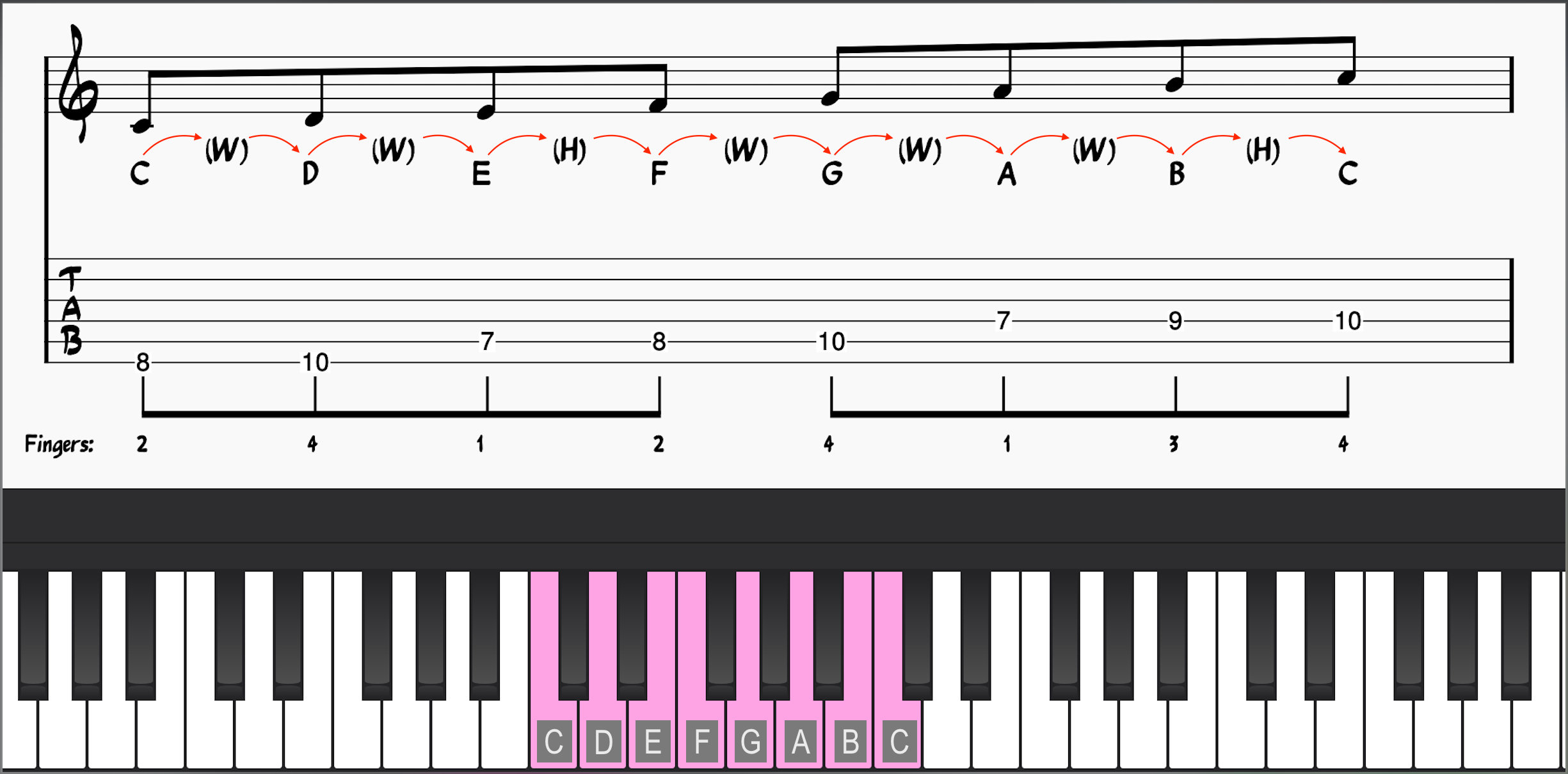
However, it would be more helpful to put that scale in context. In the next image, you’ll see one octave of the major scale sequence surrounded by its adjacent octaves:
- Note Names: …C-D-E-F-G-A-B-C-D-E-F-G-A-B-C-D-E-F-G-A-B-C…
- Scale Formula: …W-W-H-W-W-W-H-W-W-H-W-W-W-H-W-W-H-W-W-W-H….
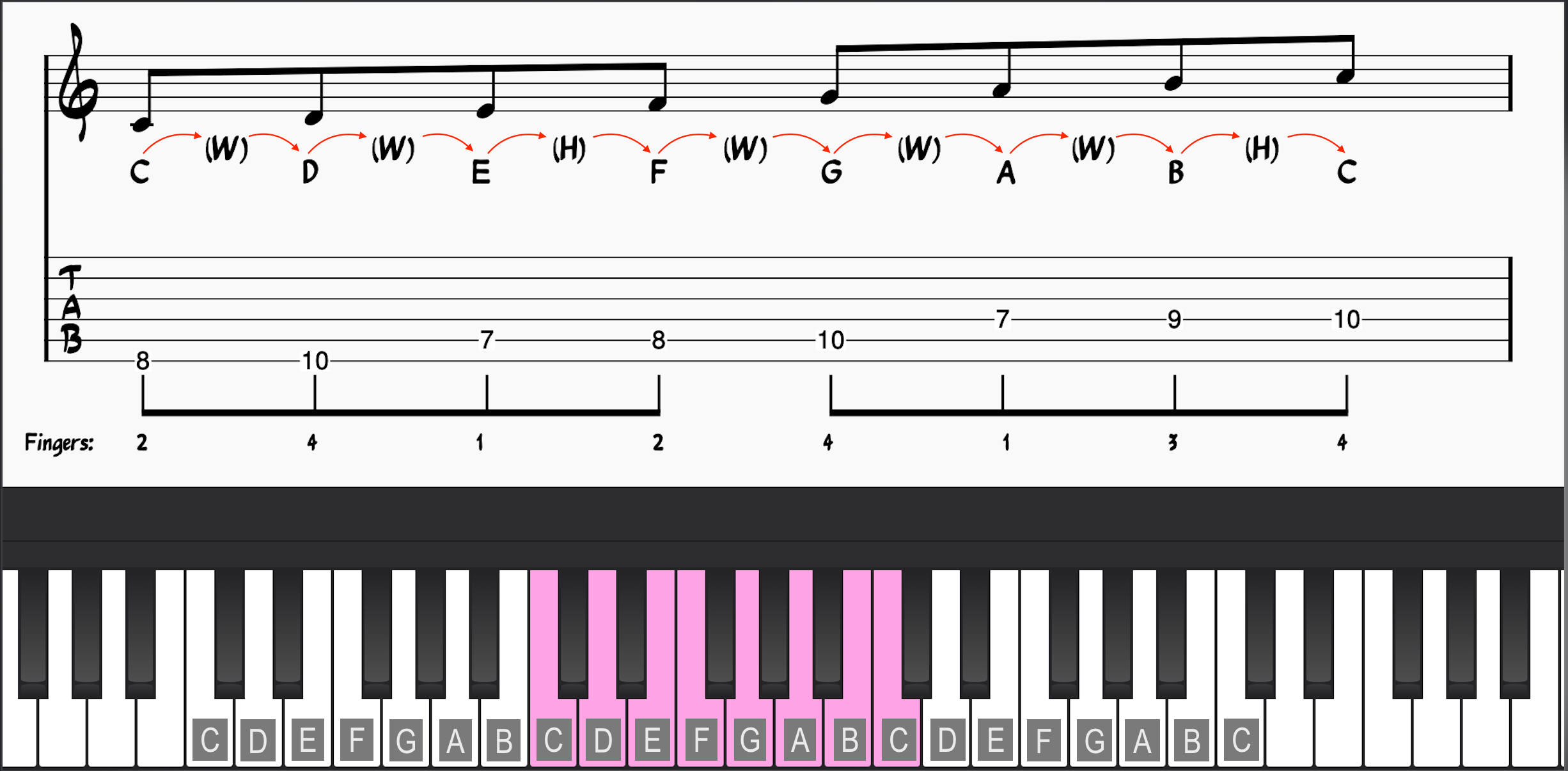
The secret to understanding the modes of the classic major scale is understanding that each note in the sequence—each of the seven scale degrees—is also a root note in its own scale.
Though the sequence of notes remains the same scale as the parent scale, you end up with different relationships between all the notes. This gives rise to seven different scales, each with their own distinct sound.
For example, instead of playing C to C: C-D-E-F-G-A-B-C…
You can play D to D using the same sequence (D-E-F-G-A-B-C-D), and you’ll end up with a minor scale with a major 6th interval (Dorian mode).
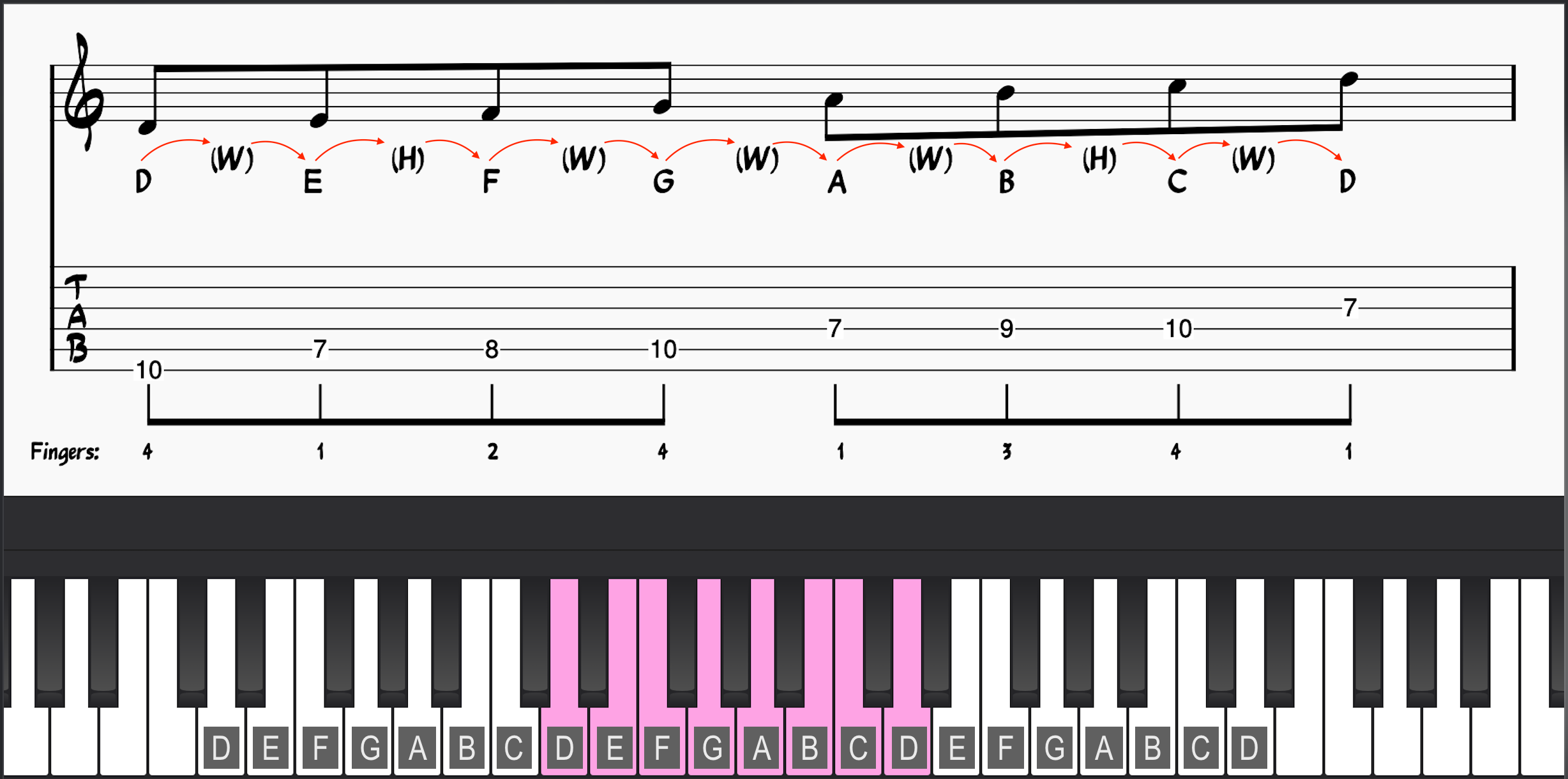
Or E to E, following the same sequence (E-F-G-A-B-C-D-E), and you’ll end up with another minor scale with a flat 2nd interval and a minor 6th interval (Phrygian Mode).
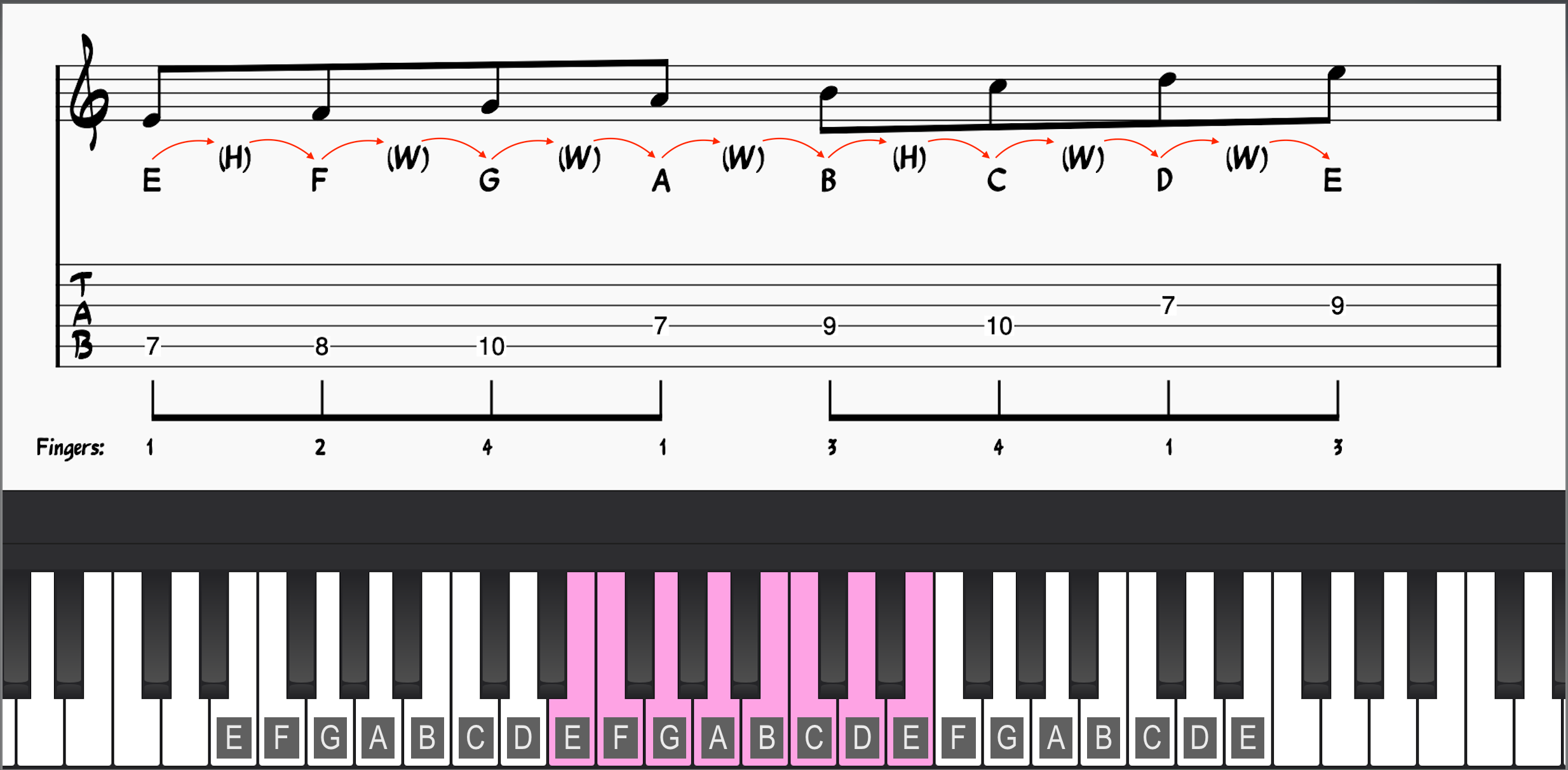
This is the secret behind musical modes! The major scale has six other scales within it. Each scale degree can function as the root note of its own scale. Here are the seven modes:
- I. C Ionian Mode
- C Major Scale Notes: C-D-E-F-G-A-B-C
- Major Scale Step Formula: W-W-H-W-W-W-H
- ii. Dorian Mode
- D Dorian Scale Notes: D-E-F-G-A-B-C-D
- D Dorian Scale Step Formula: W-H-W-W-W-H-W
- iii. Phrygian Mode
- E Phrygian Scale Notes: E-F-G-A-B-C-D-E
- E Phrygian Scale Step Formula: H-W-W-W-H-W-W
- VI. Lydian Mode
- F Lydian Scale Notes: F-G-A-B-C-D-E-F
- F Lydian Scale Step Formula: W-W-W-H-W-W-H
- V. Mixolydian Mode
- G Mixoydian Scale Notes: G-A-B-C-D-E-F-G
- G Mixolydian Scale Step Formula: W-W-H-W-W-H-W
- Check out our article on the Mixolydian Scale
- vi. Aeolian Mode
- A Natural Minor Scale Notes: A-B-C-D-E-F-G-A
- A Natural Minor Scale Step Formula: W-H-W-W-H-W-W
- viiø. Locrian Mode
- B Locrian Scale Notes: B-C-D-E-F-G-A-B
- B Locrian Scale Step Formula: H-W-W-H-W-W-W
For more on the modes of the major scale, check out our guide to the musical modes.
The Lydian Scale Formula, Diatonic IV Chords, and Music Theory
Let’s analyze the Lydian mode in more detail to understand what makes it unique.
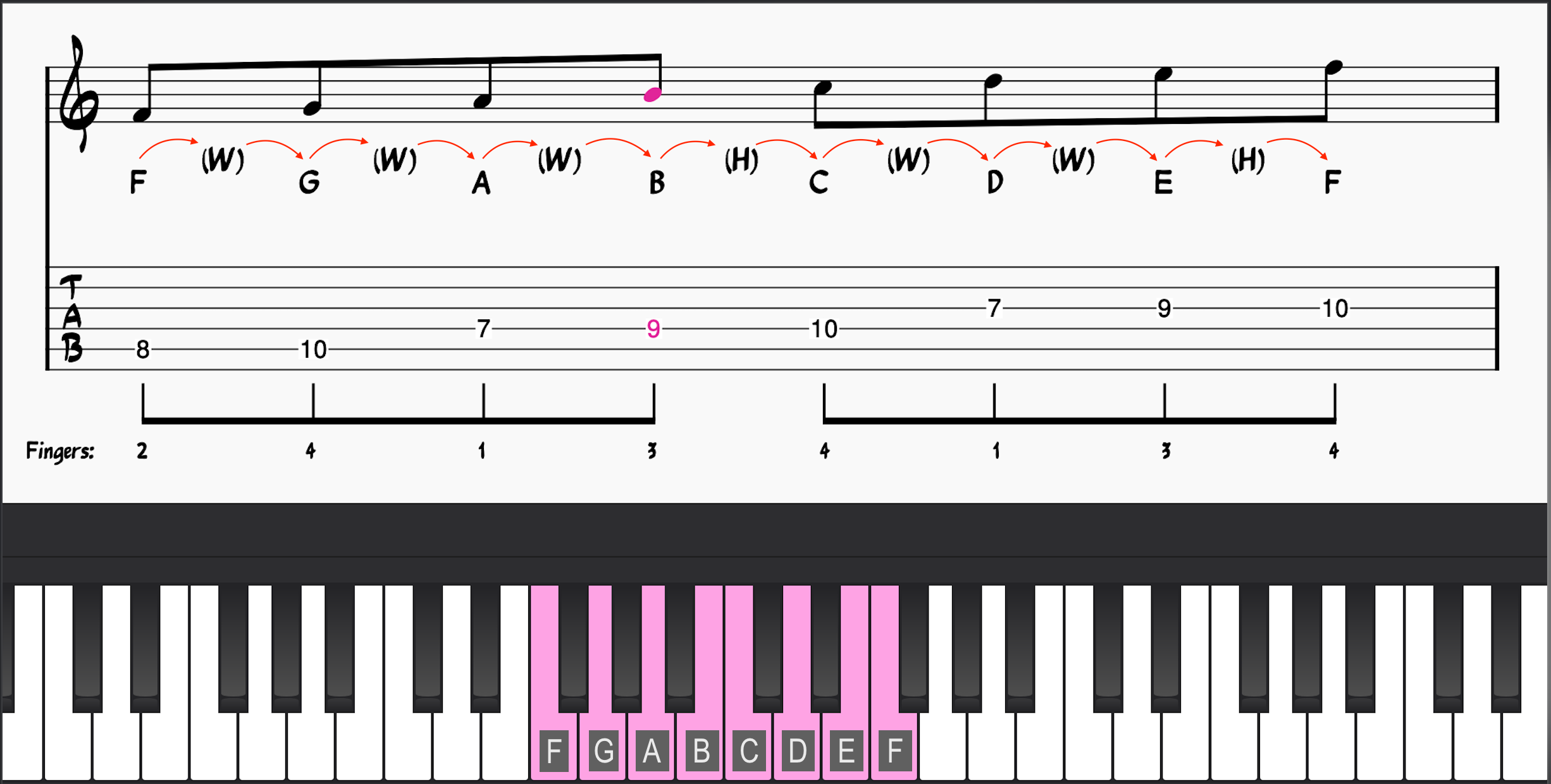
We get the Lydian mode when we play the major scale starting on its fourth note.
- Here is the major scale formula: W-W-H-W-W-W-H
- And here is the Lydian scale formula: W-W-W-H-W-W-H
The sequence is the same, and each is made from the same notes, but the starting point is different, and therefore, the relationships within the scale shift.
The Lydian sound is unique and often described as brighter than the standard major scale. This is because of the raised fourth degree found in the scale.
The intervallic relationship between the root note (F) and the augmented fourth scale degree (B natural) is a tritone, and it’s the tritone between the root and the augmented fourth scale degree that gives the Lydian mode its unique sound.
The Lydian mode’s corresponding diatonic chord is a major chord built from the fourth note of the scale. In the key of C, this gives us an F major chord.
Here are the diatonic chords in the key of C:
- I. C major (C-E-G)
- ii. D minor (D-F-A)
- iii. E minor (E-G-B)
- IV. F Major (F-A-C)
- V. G Major (G-B-D)
- vi. A Minor (A-C-E)
- viiø. B Diminished (B-D-F)
It’s no coincidence that the fourth mode is a major scale with a raised fourth degree, and the IV chord in major keys is a major chord. Diatonic chords are derived from the relationships found within the major scale and its modes.
Chords and their related scales are essentially the same musical concepts presented in different forms—just like ice and liquid water are two forms of the same type of molecule.
The Lydian mode works well over IV chords in diatonic chord progressions because the IV chord and the Lydian scale are essentially the same musical concept. (More on that later…)
Now that we understand the Lydian mode let’s learn it in all 12 keys!
All 12 Lydian Scales on Guitar and Piano
Here are all 12 Lydian scales on guitar and piano. Also, check out the audio recordings and listen specifically for the raised fourth degree in each scale.
C Lydian Scale (G Major)
C-D-E-F#-G-A-B-C
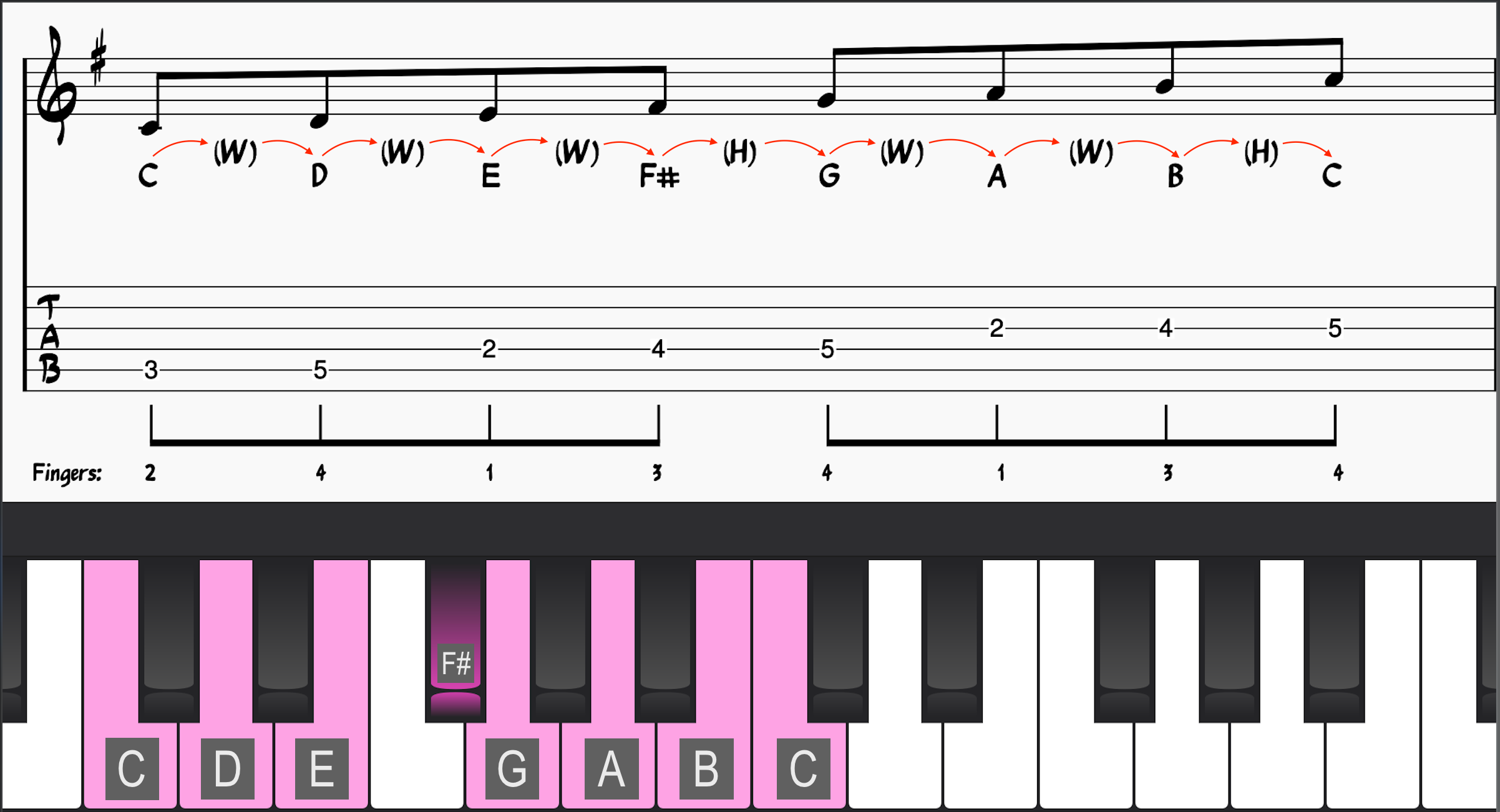
F Lydian Scale (C Major Scale)
F-G-A-B-C-D-E-F
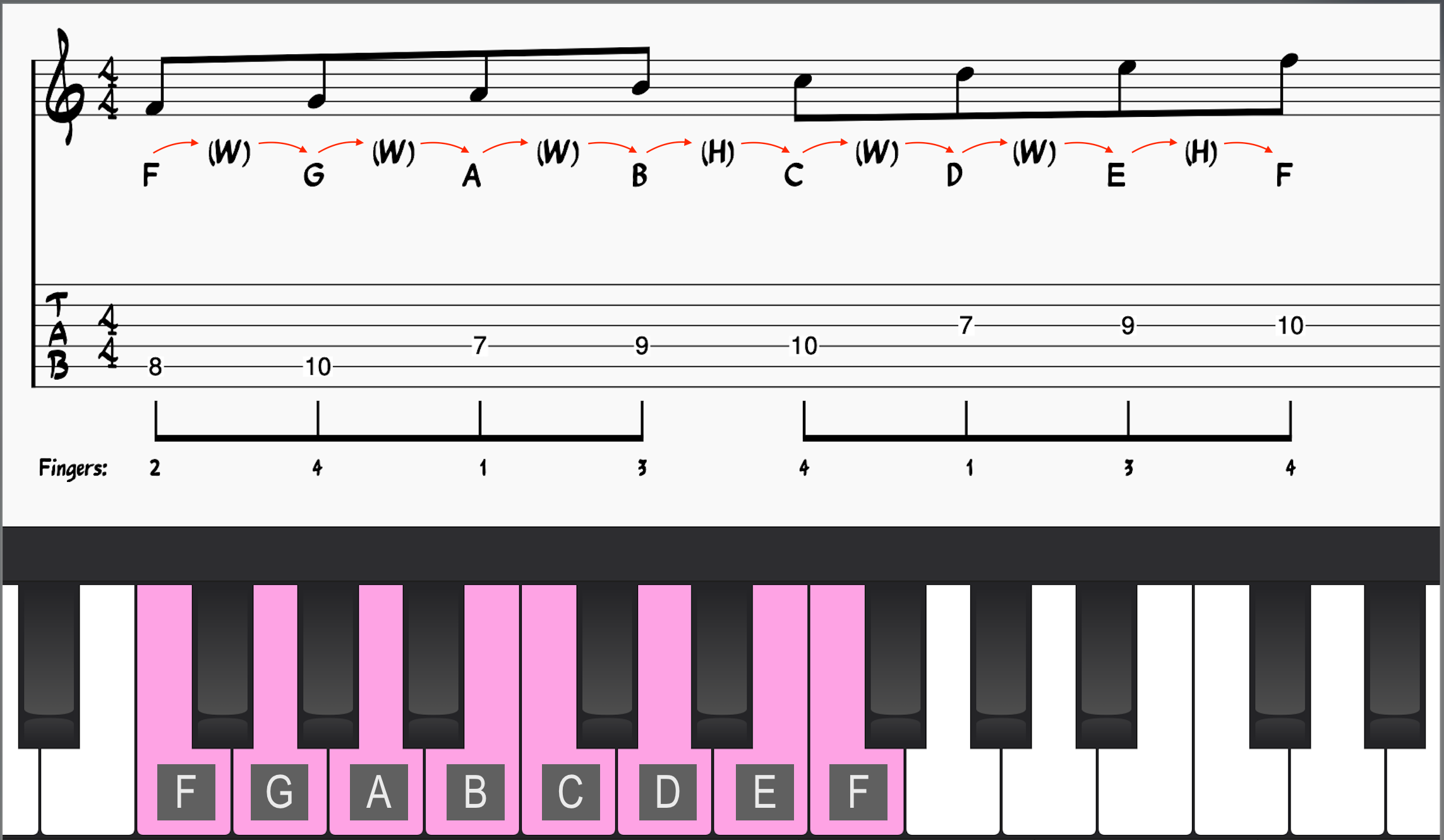
Bb Lydian Scale (F Major)
Bb-C-D-E-F-G-A-Bb
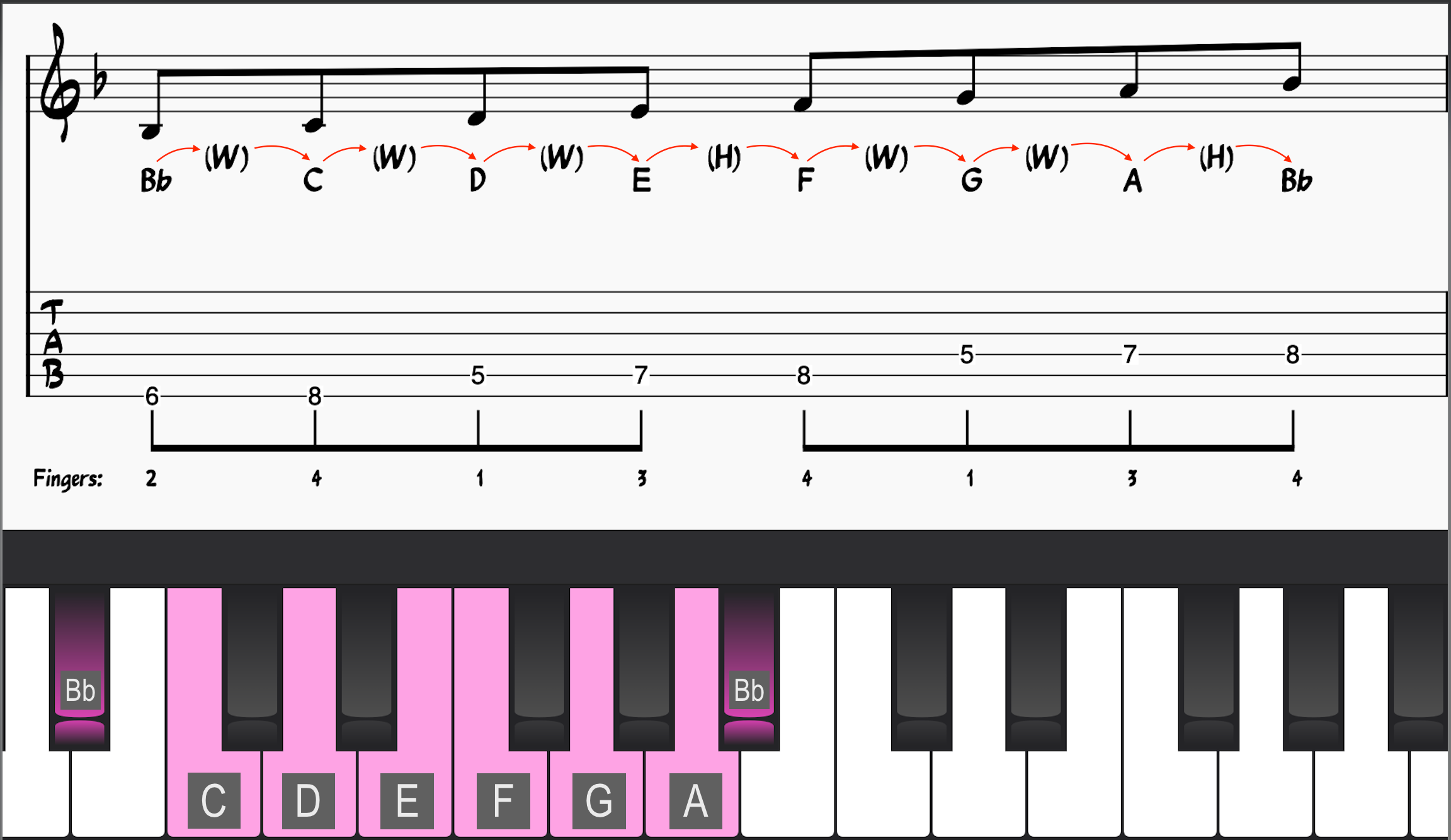
Eb Lydian Scale (Bb Major)
Eb-F-G-A-Bb-C-D-Eb
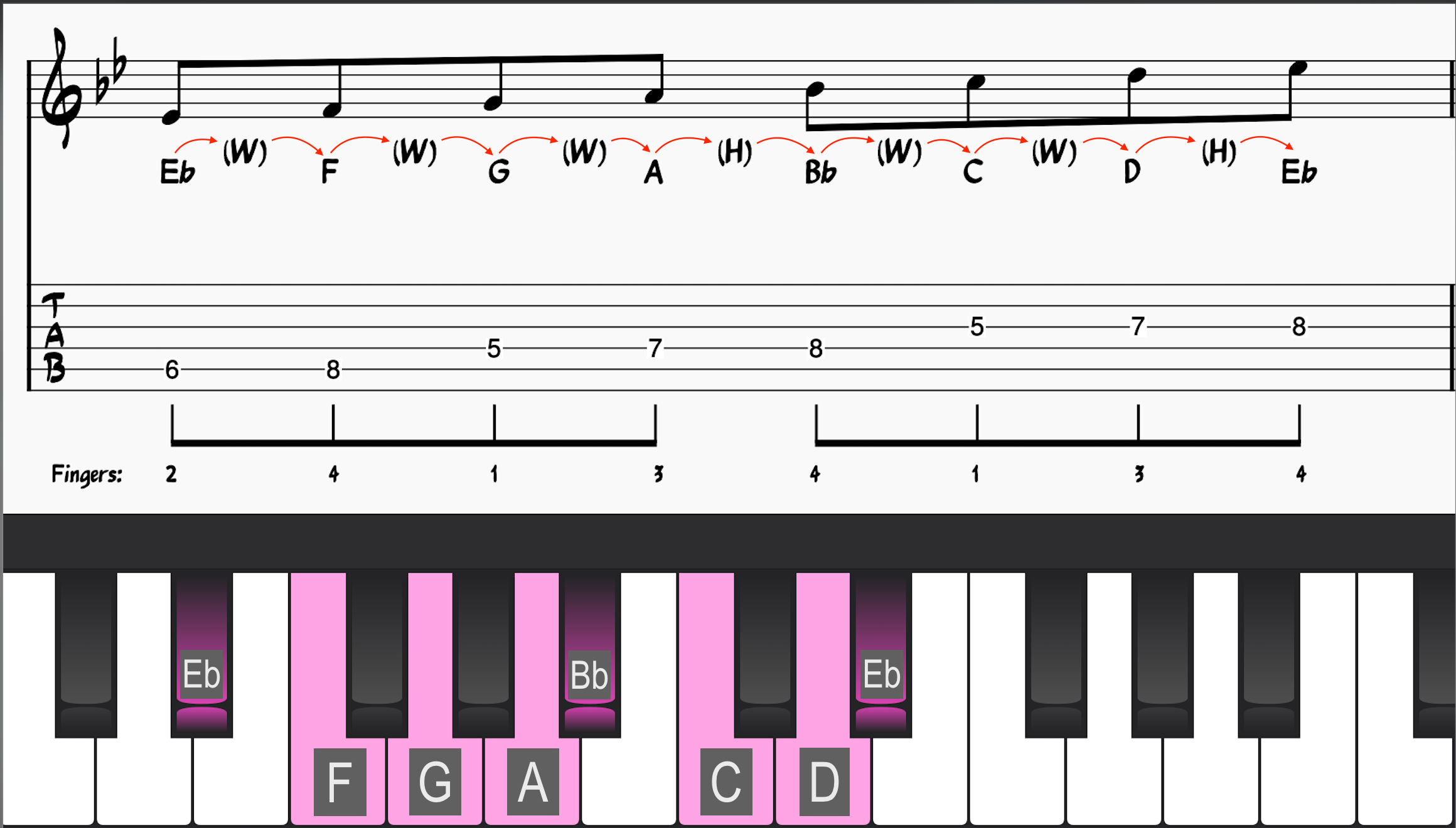
Ab Lydian Scale (Eb Major)
Ab-Bb-C-D-Eb-F-G-Ab
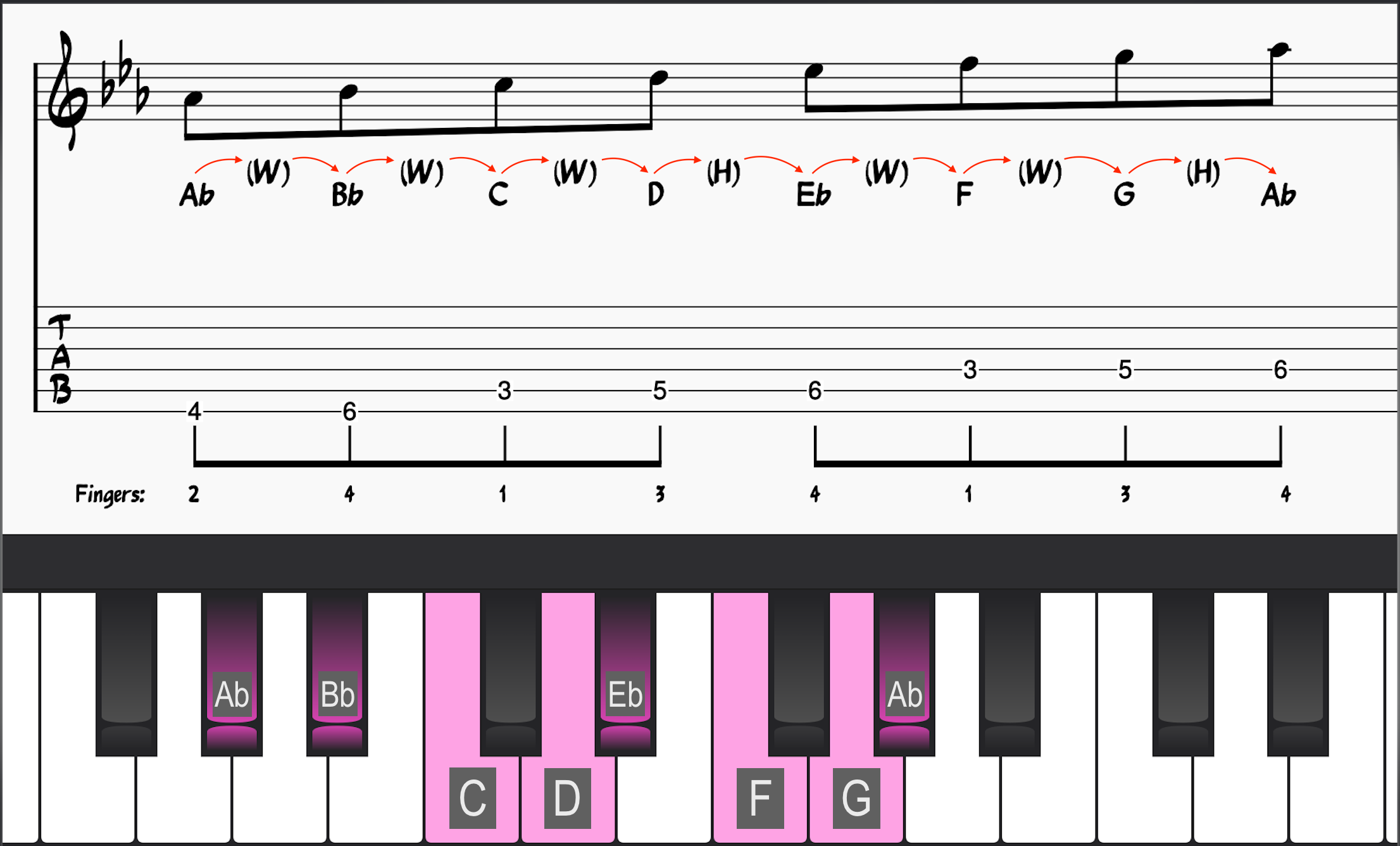
Db Lydian Scale (Ab Major)
Db-Eb-F-G-Ab-Bb-C-Db
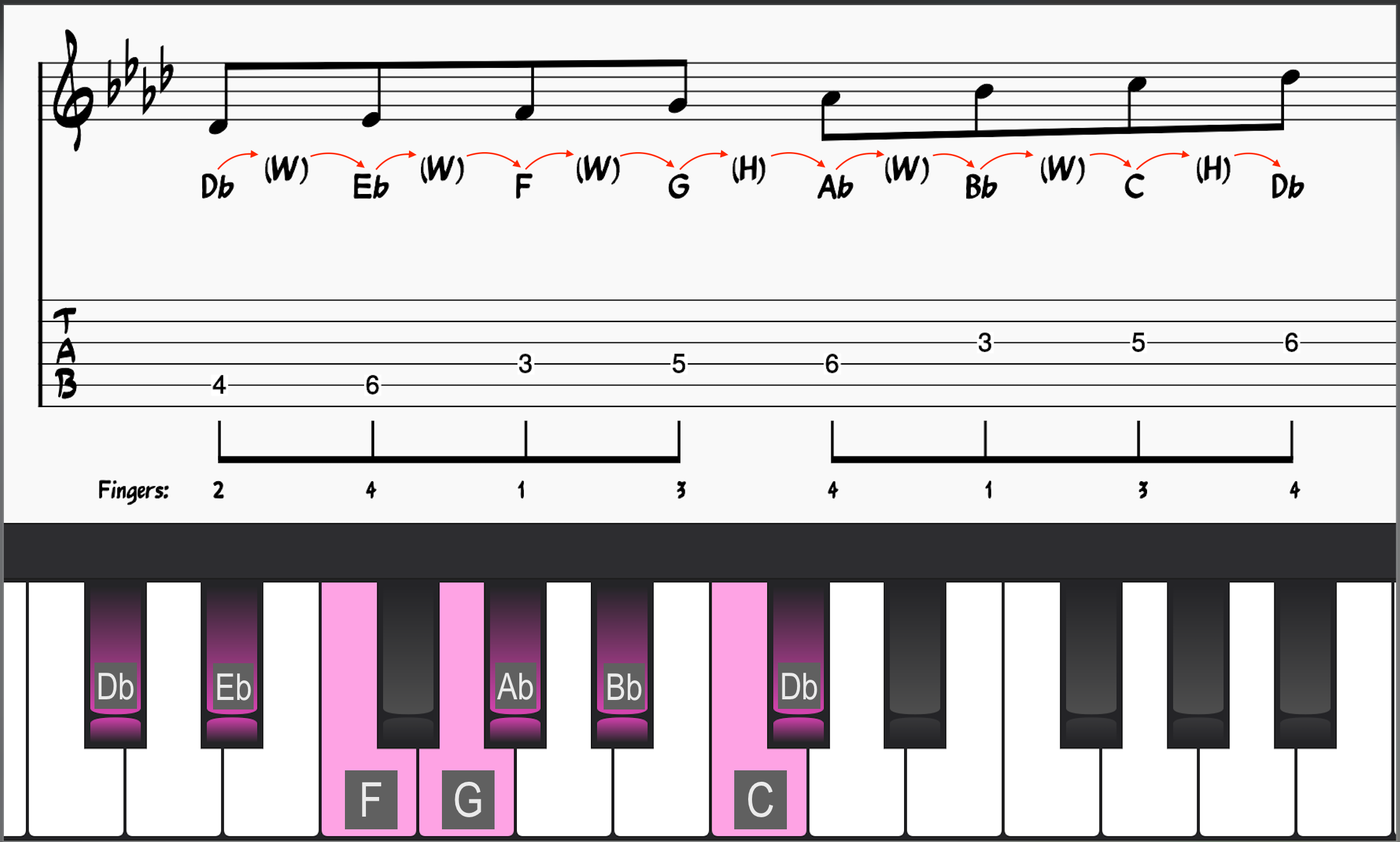
Gb Lydian Scale (Db Major)
Gb-Ab-Bb-C-Db-Eb-F-Gb
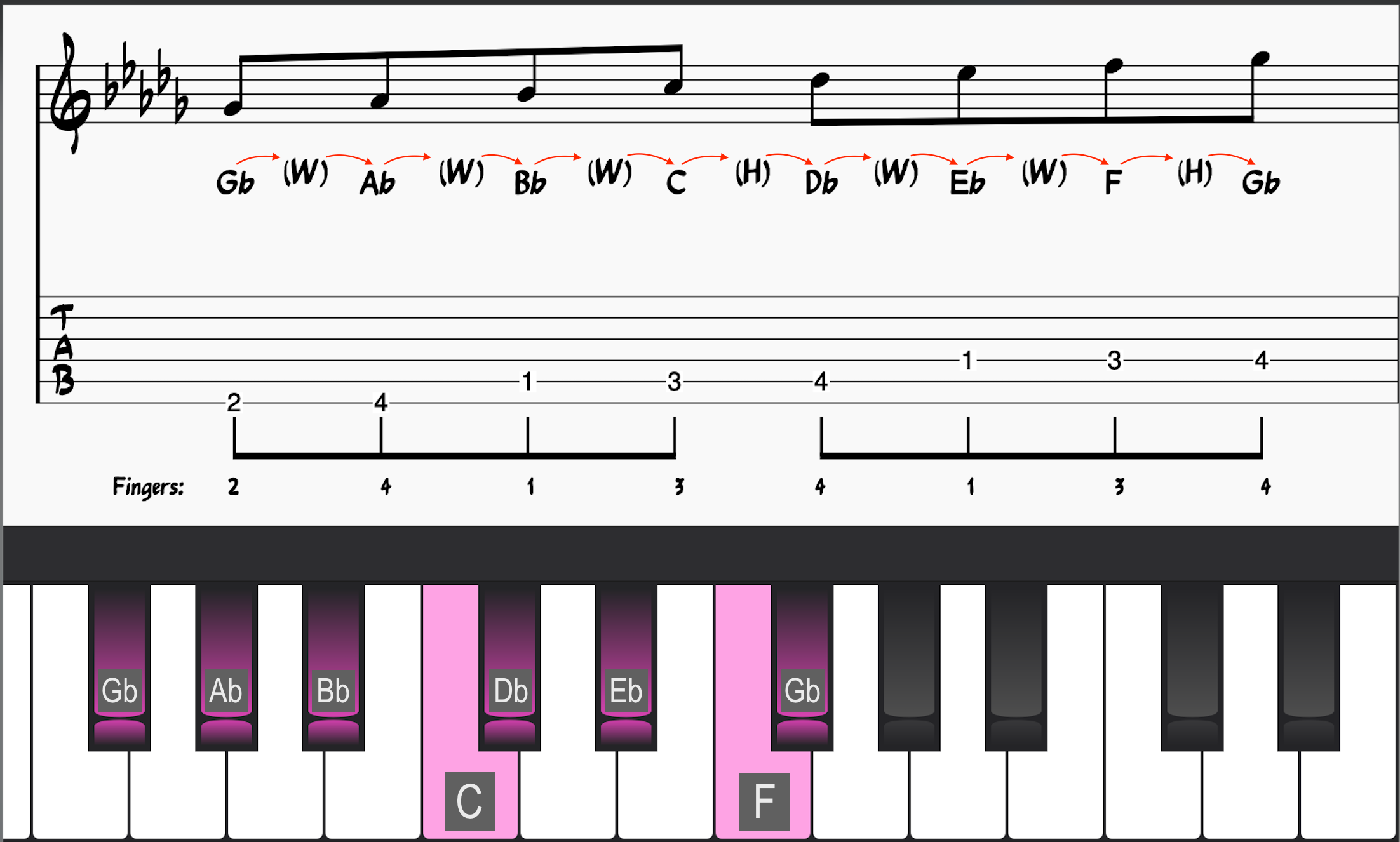
B Lydian Scale (F# Major)
B-C#-D#-E#-F#-G#-A#-B
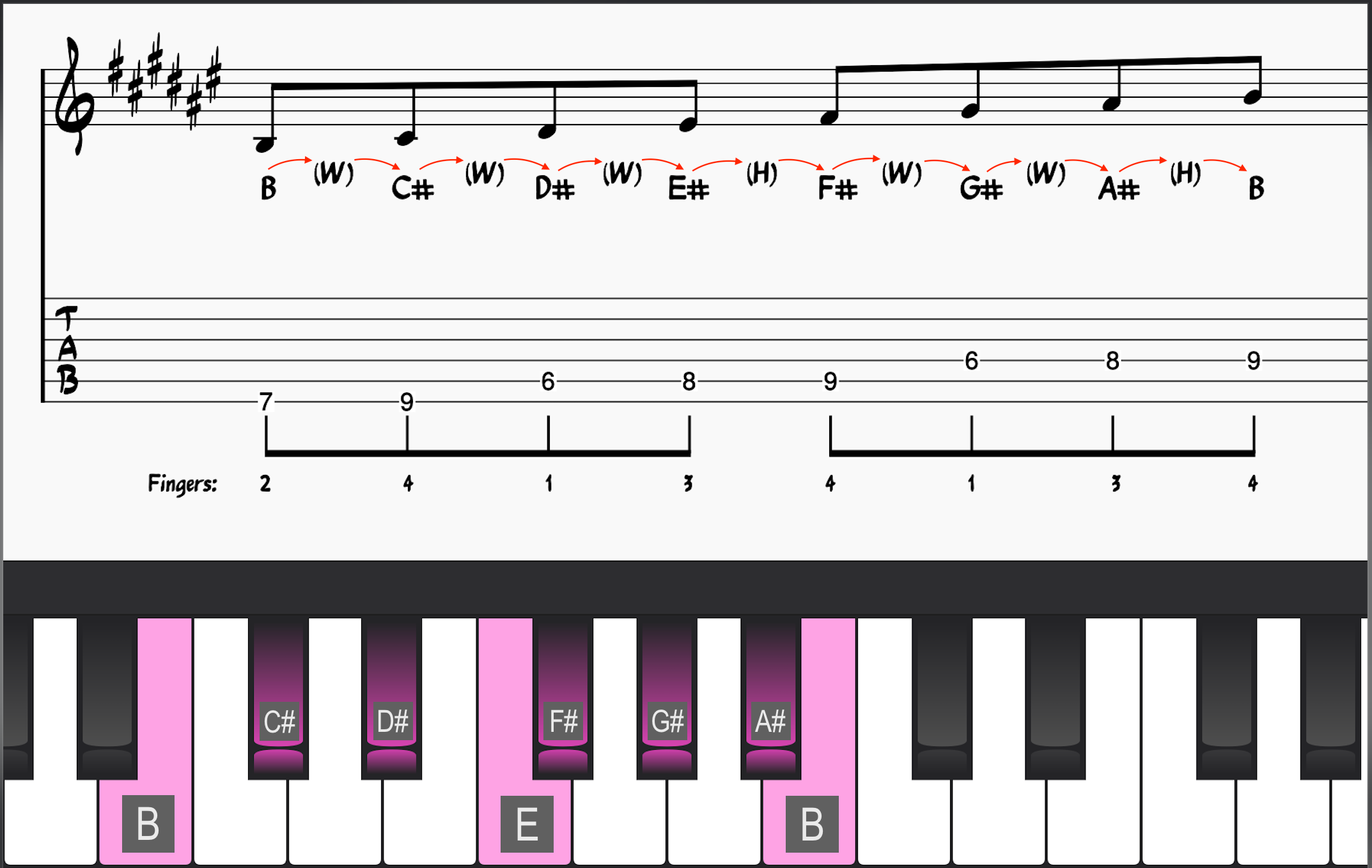
E Lydian Scale (B Major)
E-F#-G#-A#-B-C#-D#-E
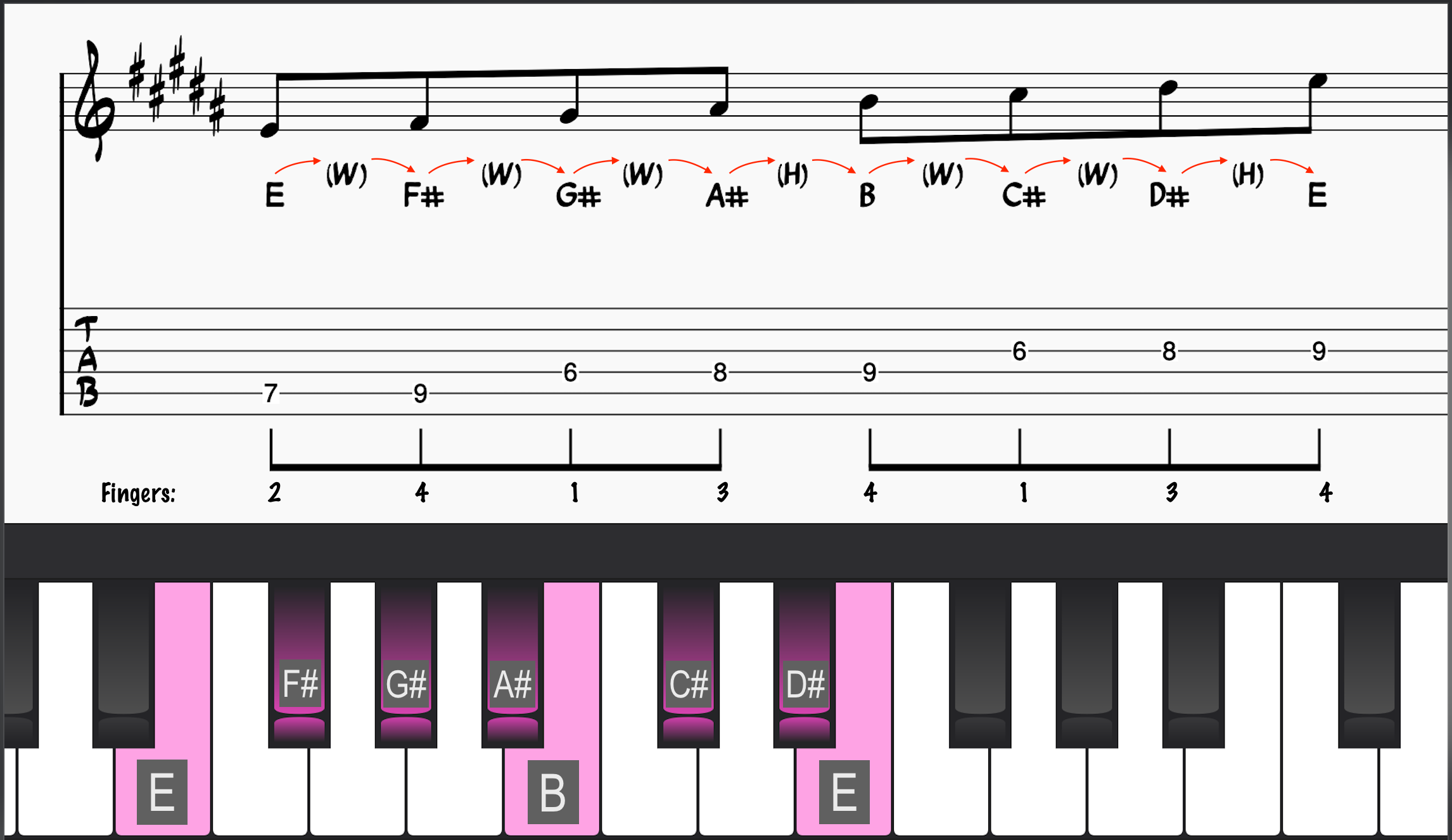
A Lydian Scale (E Major)
A-B-C#-D#-E-F#-G#-A
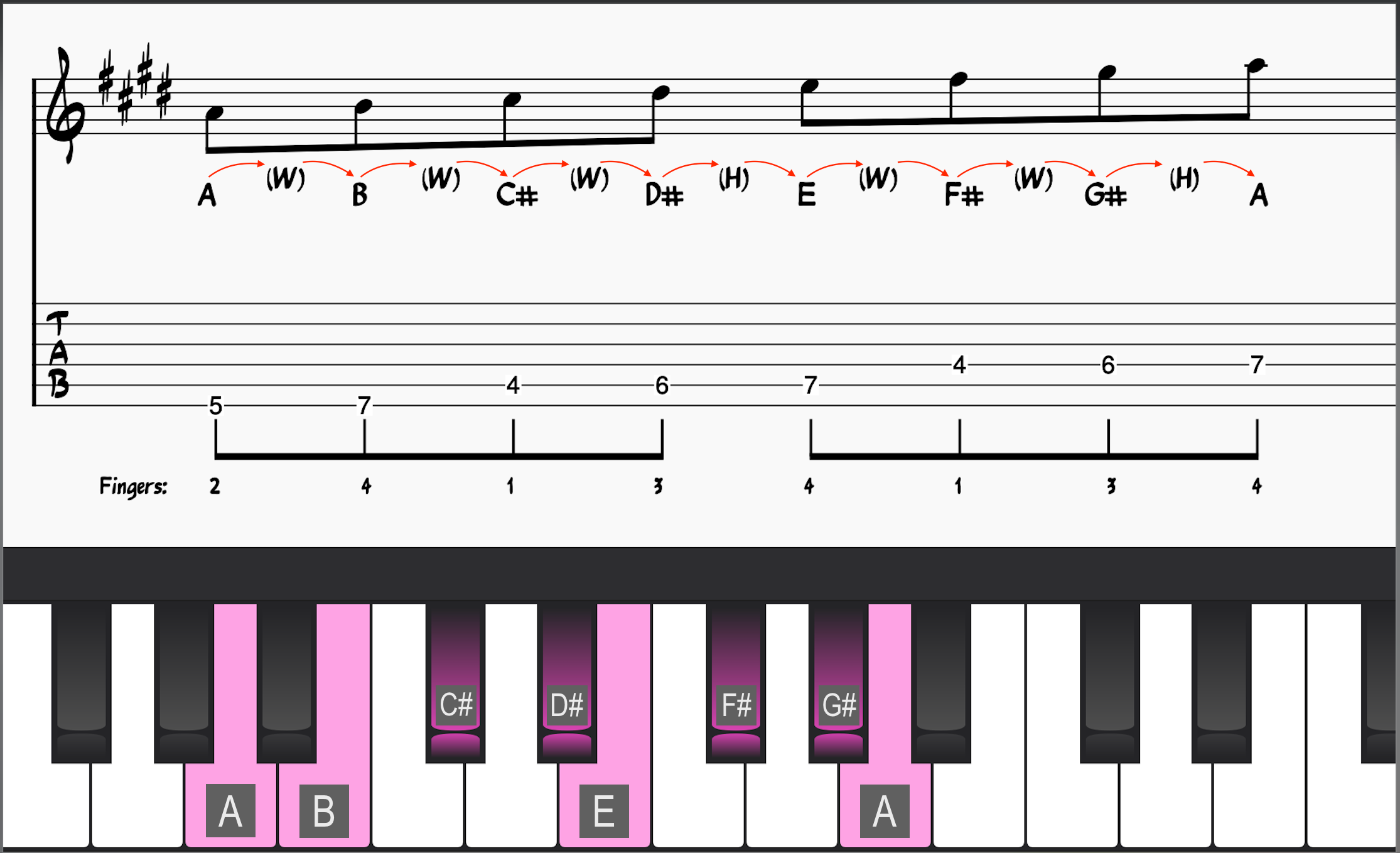
D Lydian Scale (A Major)
D-E-F#-G#-A-B-C#-D
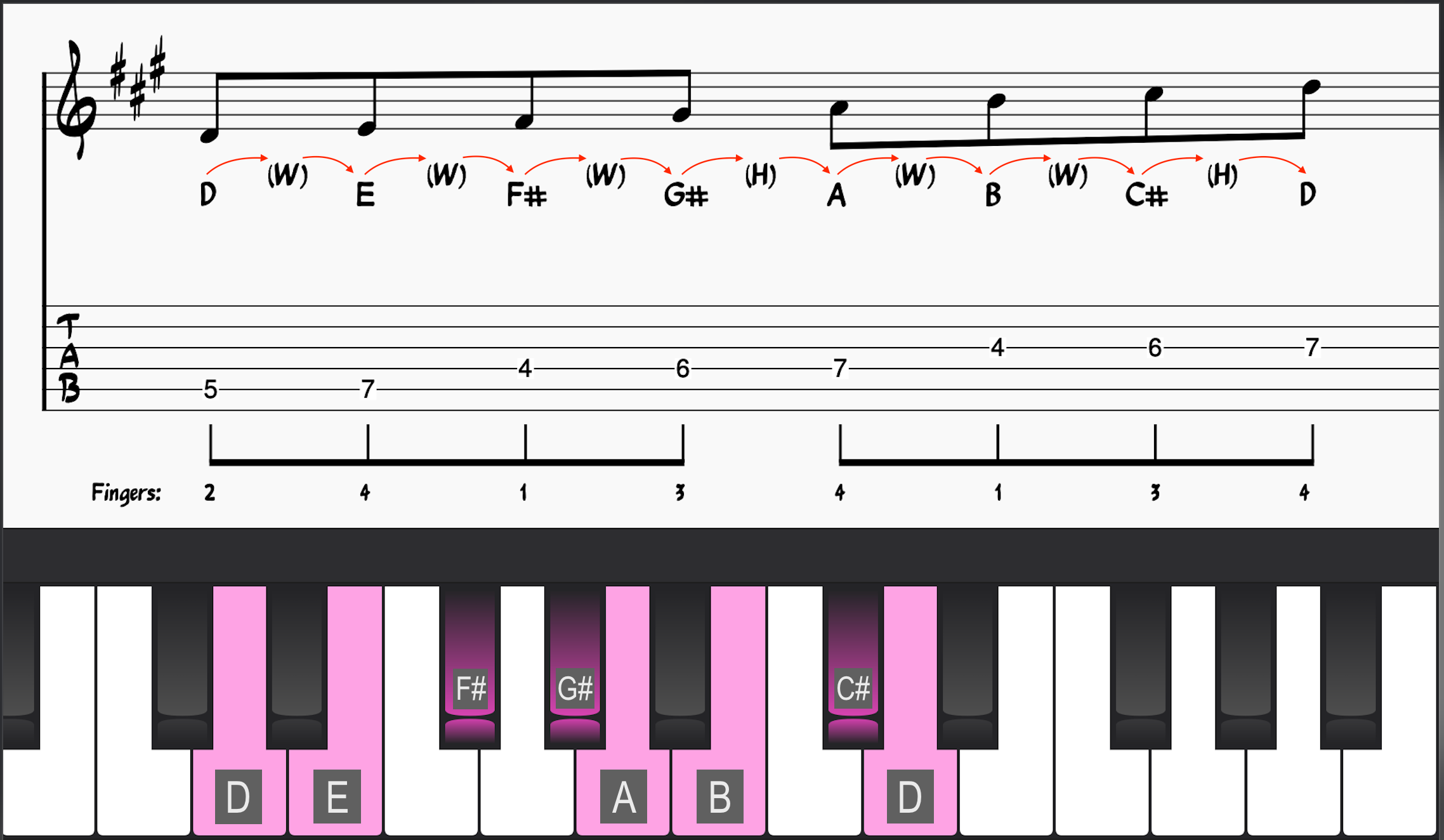
G Lydian Scale (D Major)
G-A-B-C#-D-E-F#-G
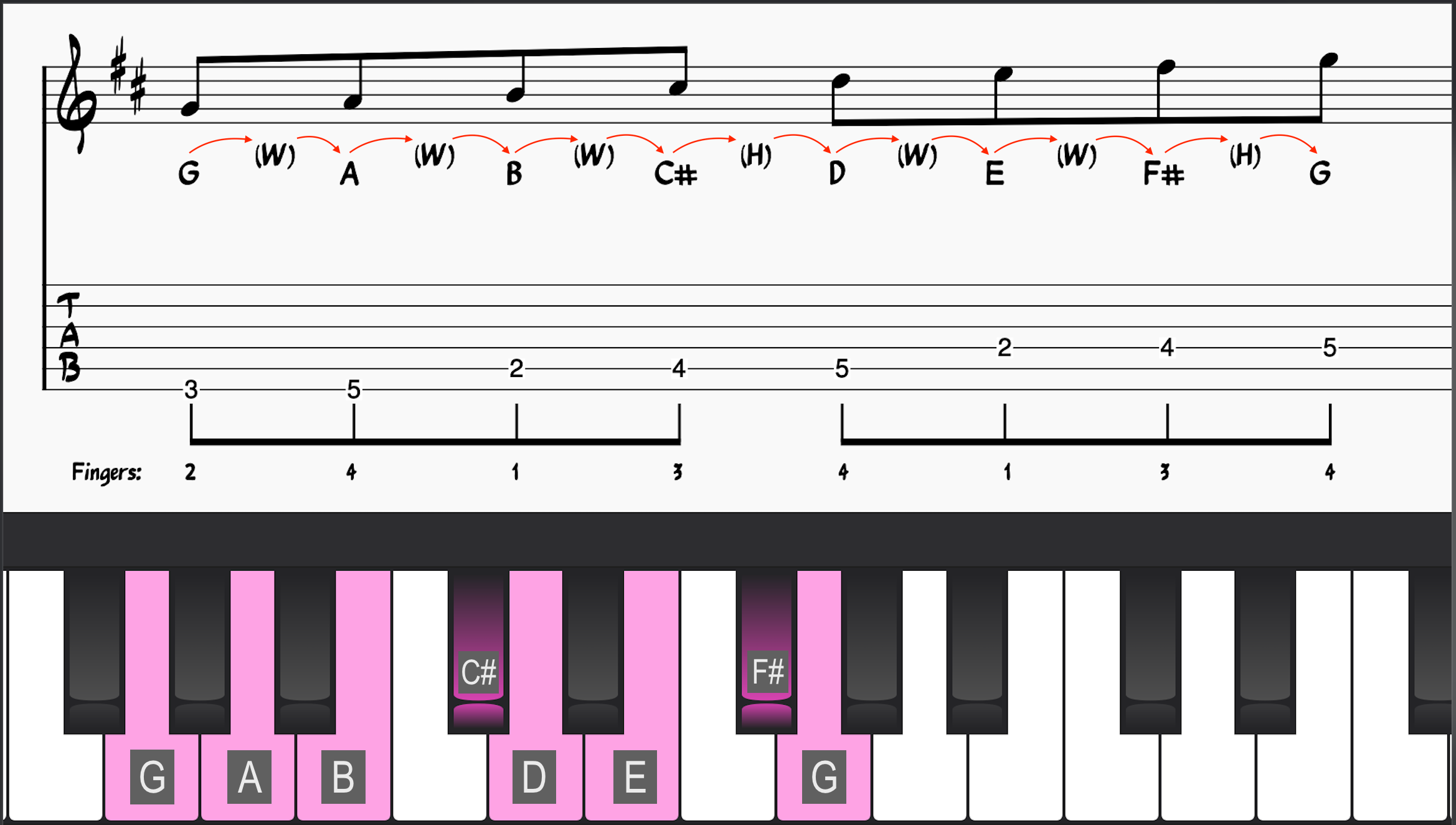
BEFORE YOU CONTINUE...
If music theory has always seemed confusing to you and you wish someone would make it feel simple, our free guide will help you unlock jazz theory secrets.

How To Use The Lydian Scale When Improvising Over Chord Progressions
Now that we understand the Lydian mode better, let’s learn some real-world, practical musical uses for it.
Diatonic IV Chords
As mentioned above, the Lydian scale and Diatonic IV chords are two forms of the same musical idea. That’s why the Lydian mode works well over IV chords in jazz chord progressions. Here is a great example:
Autumn Leaves
Though Autumn Leaves is technically in G-, we will label the chords as if it was in the relative major key of Bb. (You’ll see the chord analysis for both G- and Bb in the image below.)
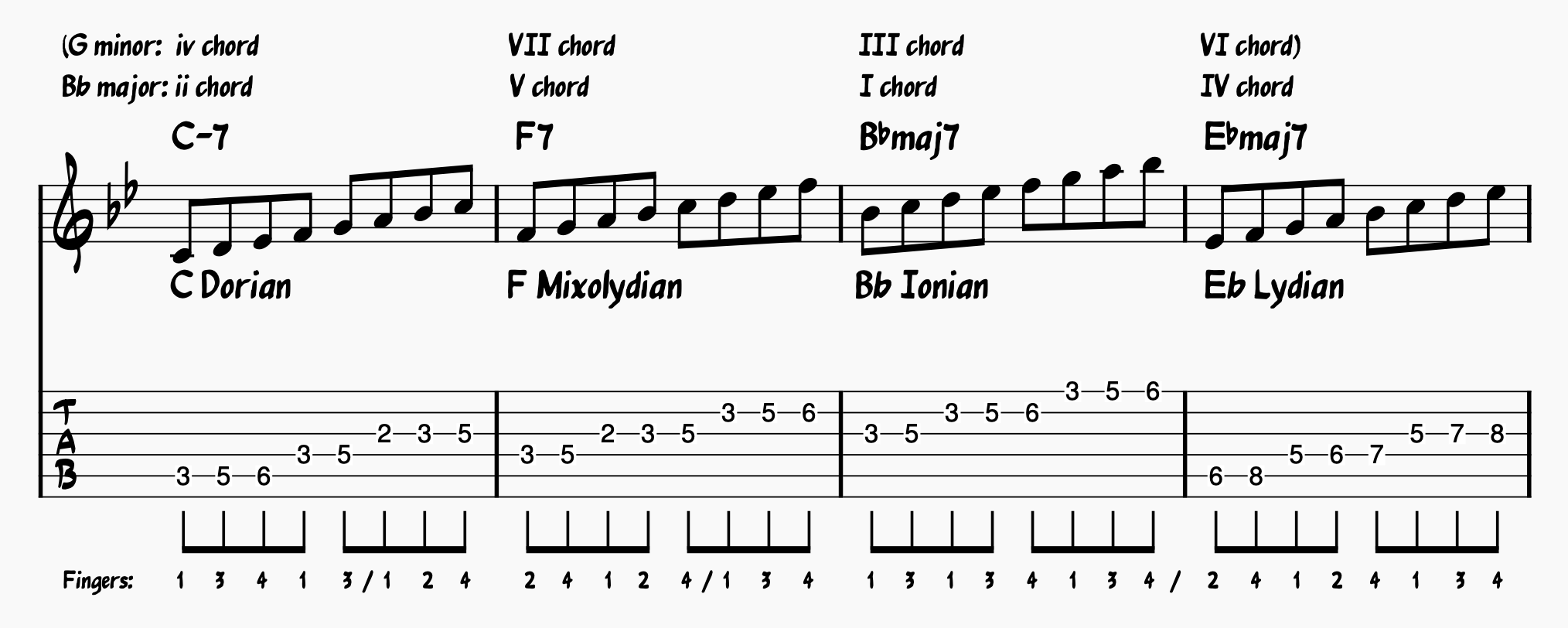
These chords are diatonic, meaning they are constructed from the notes in that particular key. Therefore, we can plug in the appropriate mode over each chord.
- Dorian (second mode) for the ii chord
- Mixolydian (fifth mode) for the V chord
- Ionian (first mode) for the I chord
- Lydian (fourth mode) for the IV chord
To learn more about the Autumn Leaves chord progression, check out our article on Autumn Leaves chords.
Maj7#11 Chords
Maj7#11 chords are 7th chords with an augmented 11th extension. Therefore, a Cmaj7#11 would be spelled:
- #11th: F#
- 7th: B
- 5th: G
- 3rd: E
- Rt: C
You’ll see maj7#11 chords written into many jazz standards. Sometimes, these chords are functionally the IV chord, but other times, they aren’t.
A great example of a tune that uses maj7#11 chords in a non-functional (non-diatonic) way is the Sam Rivers tune Beatrice. This tune is full of many parallel maj7#11 chords and is considered a hybrid tune that uses modal changes and functional harmony.
Learn more about the tune Beatrice here.
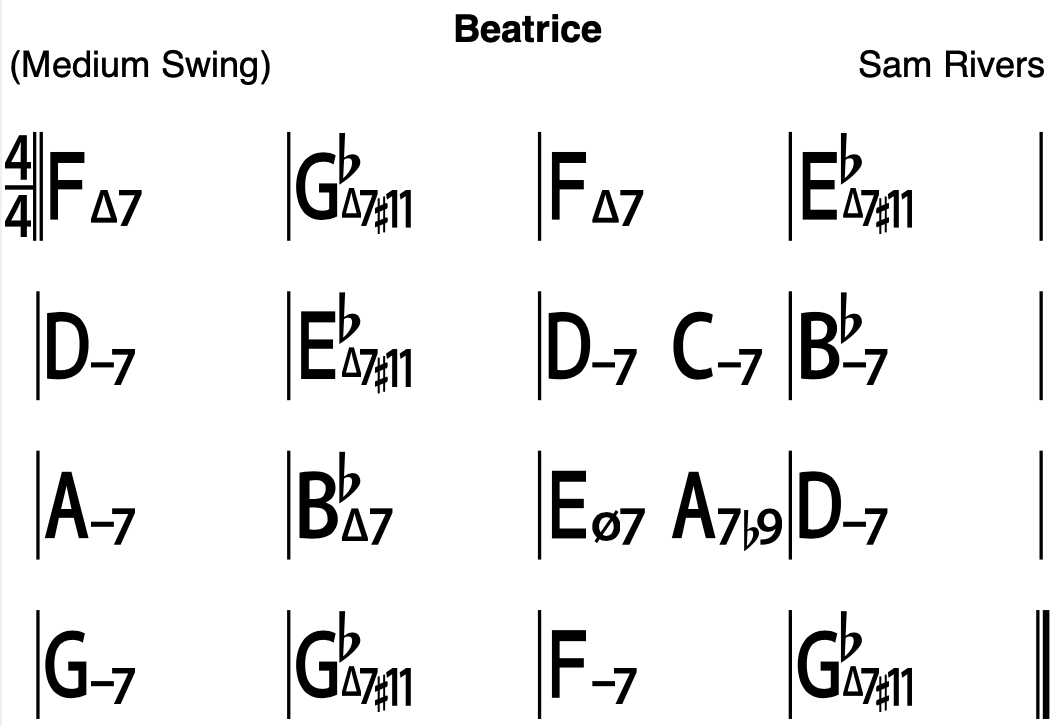
Imposing the Lydian Sound Over a Tonic I Chord
You can also impose the Lydian sound over the I chord to brighten it up a bit and create some interest and variation.
In jazz recordings and performances, players might play a Lydian-inspired lick at the end of the tune to give it more of a “whole-tone scale” sound and leave the resolution to the tonic more unsettled.
Taking the Lydian Scale Further
Though it has its own unique sound, the Lydian mode is ultimately bound to its parent scale (the major scale). However, jazz music often pulls from non-diatonic harmony to create rich harmonies full of tension not accessible by the major scale alone.
However, there are two melodic minor scale modes that make use of the Lydian sound but take it even further:
Lydian Augmented Scale (3rd Mode of Melodic Minor)
The Lydian Augmented scale is a Lydian scale with a sharp or augmented fifth. It also makes the Lydian sound even brighter by raising the 5th scale degree.
- An F Lydian scale is spelled: F-G-A-B-C-D-E-F and is the fourth mode of C major.
- An F Lydian Augmented scale is spelled: F-G-A-B-C#-D-E-F and is the 3rd mode of D Melodic Minor.
This scale works over Maj7#5 chords.
Lydian Dominant Scale (4th Mode of Melodic Minor)
The Lydian Dominant scale is another important jazz scale. It’s a Lydian scale with a minor 7th interval instead of a major 7th interval.
- An F Lydian scale is spelled: F-G-A-B-C-D-E-F and is the fourth mode of C major.
- An F Lydian Dominant scale is spelled: F-G-A-B-C-D-Eb-F and is the fourth mode of C Melodic Minor.
This works really well over dominant chords with a #11 chord extension.
For more on the modes of melodic minor and how this scale is essential to jazz music, check out our guide to melodic minor modes. Also, check out our article on essential jazz scales you need to know!
Want To Master Jazz Scales and Solo Like a Pro? Join the Learn Jazz Standards Inner Circle
If you want to take your jazz chops and music theory knowledge to the next level, then check out the Learn Jazz Standards Inner Circle.
The Inner Circle has everything you need to bust through practice plateaus and reach the next stage of your jazz journey.



